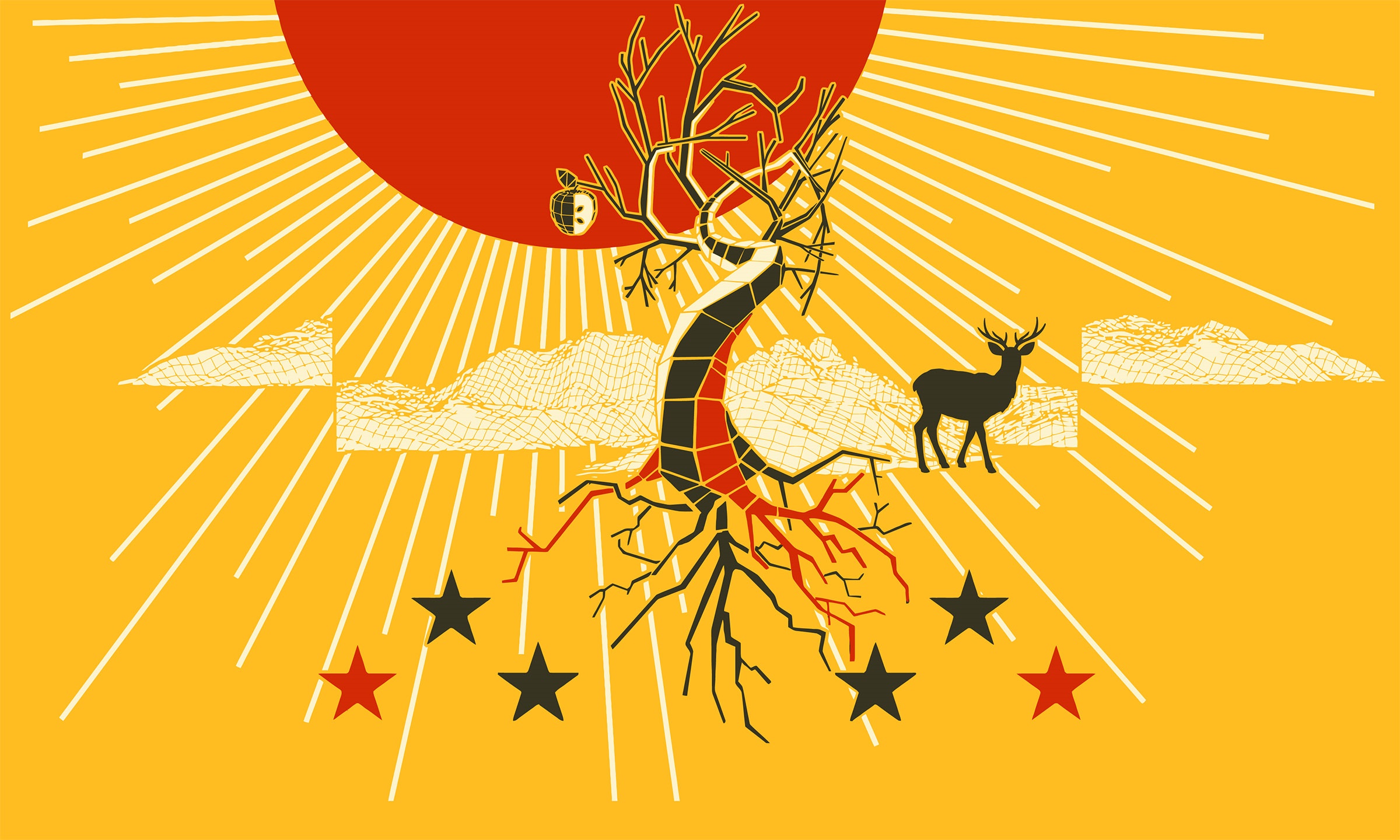The Momentary Flag Project: Olalekan Jeyifous
The Momentary Flag Project asks artists to explore the symbolic resonance of flags and consider how they shape our understanding of place and identity. Through this project, we hope to continue adding new stories and perspectives to the history of the Momentary’s site. On January 15, the Momentary Flag Project welcomed its third flag designed by Nigerian American artist Olalekan Jeyifous. Learn more about the artist and his flag, All you touch, you change. All you change, changes you (2020), here and see the flag at the Momentary on the site’s historic flag pole, located on E St.

About the Artist
Trained in architecture at Cornell University, Jeyifous blends techniques and skills from the field with speculation drawn from a range of science fiction imaginaries from Afrofuturism—a cultural aesthetic that fuses futurism, liberation, and African American history—to Solarpunk—a genre that envisions possible ecological futures under climate crisis. Best known for his digital illustrations in the series Shantytown Megastructures, an imagined Lagos, Nigeria in which contemporary ad hoc construction practices are extrapolated into fantastical vertical settlements, his practice crosses between disciplines and mediums, taking shape as drawings, films, installations, and large-scale public art.
Jeyifous’s work has been shown at the Shenzhen Biennale of Architecture and Urbanism, the Studio Museum in Harlem, and the Guggenheim Bilbao. His large-scale public artworks were shown at Coachella in 2017 and recently along the waterfront in Alexandria, Virginia. He is one of the participants in the 2020-21 cycle of Exhibit Columbus and the upcoming MoMA exhibition, Reconstructions: Architecture and Blackness in America.
Jeyifous creates work that critiques the present by looking at the past as well as the future. The future that Jeyifous imagines blurs science fiction and reality, since the conditions that allow for such futuristic moments to take place are within reach. Perhaps it is this immanent futurity that feels dystopian and, at the same time, reminds us of our living present that renders his work simultaneously inspirational and cautionary. Jeyifous’s aesthetic has powerful urgency because it makes us think about how humanity should configure a sustainable future in the face of population growth and atmospheric crisis.

Jeyifous’s Flag and Octavia Butler’s Parable of the Sower
Science fiction narratives often examine the problems of the present by exacerbating them in an imagined future or resolving them in tenuous ways. One such narrative, Octavia Butler’s Parable of the Sower, first published in 1993, served as the inspiration for Jeyifous’s flag. In it, civil society and cultural norms have crumbled, crime, violence, and addiction are rampant, and environmental degradation and economic collapse have pushed most to roam about the country searching for food, while others take refuge in walled compounds run by corporations whose power is unchecked. The portrait is an all-too-plausible extrapolation of contemporary pressures and the propensity to violence and aggression that is a constant in human societies. Though the book’s depictions are incredibly violent, it speaks to a profound catalytic moment that is also incredibly hopeful. Much of that hope is embodied in the fictional, non-dogmatic faith Earthseed, which features the verse:
All that you touch
You Change.
All that you Change
Changes you
The only lasting truth
is Change.
God
is Change.
-From Parable of the Sower, Butler
Earthseed is represented as a philosophy of immanence, of living from within—rather than trying to escape—the world’s boundaries, of coping with and adapting to what occurs. In looking at Jeyifous’s flag, how do the symbols, shapes, and figures reflect this idea?

Visual Elements of the Flag
The flag also incorporates visual elements that recall the Osage creation story, as well as the history of the Momentary’s site. In the Osage creation story, the sun is the father of the Osage. After the Osage were told to leave the sky and go down to the earth, it was the elk, through the giving of his body, who created the land and all the features on it that enabled the Osage people to live (Besaw, Hopkins, Well-Off-Man). In Jeyifous’s flag, viewers can see a red sun, as well as a deer or elk-like figure near the tree.
In the nineteenth century, Benton County was becoming known for its agricultural success with produce such as apples and strawberries. The Momentary’s site had several landowners throughout the years, including a renowned architect named Charles A. Blanck. Bentonville’s 1903 Atlas depicts the division of Blanck’s apple orchard on the site—a notable addition that has carried through the site’s history. Could the apple hanging on the tree in Jeyifous’s flag be a reference to the Momentary?
How do all these references combine to tell a story? How does the flag reflect our current moment? Take some time to reflect on these questions and others during your next visit to the Momentary as the flag waves overhead.
Written by Taylor Jasper, curatorial assistant, the Momentary.
Reference:
Besaw, Mindy; Hopkins, Candace; Well-Off-Man, Manuela, Art for a New Understanding: Native Voices, 1950s to Now, 2018, The University of Arkansas Press, Fayetteville, p. 136.



